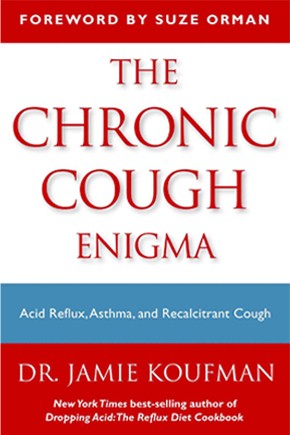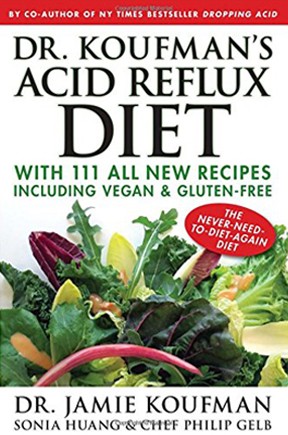At-A-Glance
- Respiratory reflux is 10x more common than heartburn GERD, and is often misdiagnosed as asthma, sinus problems, or sleep apnea.
- Pepsin—not acid—is the main cause of tissue damage in silent reflux.
- PPIs don’t stop reflux and may increase long-term health risks.
- Standard reflux testing misses respiratory reflux entirely.
- Late-night eating, alcohol, and soda are primary reflux triggers.
- A reflux-safe diet and lifestyle are the only lasting solutions.
Join Dr Jamie Koufman on Facebook Live at noon EST on the first Wednesday of each Month. If you miss it live, you can also see it on YouTube.
Acid reflux is one of the most common medical complaints in the U.S., but many people don’t realize how varied—and serious—its symptoms can be. If you’ve been struggling with chronic cough, throat issues, or unexplained breathing problems, respiratory reflux may be playing a larger role than you think.
This article outlines ten essential facts that can help you better understand your symptoms, avoid common misdiagnoses, and find a more effective path to healing.
1. Respiratory Reflux (also called Silent Reflux or LPR) Is 10 Times More Common Than Heartburn GERD
When people think of acid reflux, they often imagine the classic symptom: heartburn—often dramatized on TV as a man clutching his chest after a heavy meal. This familiar image reflects GERD (gastroesophageal reflux disease), which affects the esophagus and causes burning discomfort.
However, the majority of reflux cases today don’t present with heartburn at all. Instead, they involve silent respiratory reflux that travels upward into the throat, sinuses, airways, and even lungs—especially during sleep. This is also known as silent reflux or laryngopharyngeal reflux (LPR).
A newer term gaining recognition is SNoRR, which stands for Silent Nocturnal Respiratory Reflux. It refers specifically to reflux that occurs during sleep and affects the respiratory system—the most common type of silent reflux that often goes unrecognized.
For every person with heartburn-related GERD, there are an estimated ten people with this silent form of reflux affecting the respiratory tract—usually without realizing it.
2. You Could Have Silent Reflux Without Even Knowing It
Because silent reflux doesn’t cause the typical burning symptoms, it often goes unrecognized. Instead, it can appear as a range of respiratory issues that most people—and even doctors—don’t associate with acid reflux.
Common symptoms include:
- Postnasal drip
- Excess mucus
- Chronic throat clearing
- Persistent cough
- Hoarseness
- Difficulty swallowing
- A sensation of a lump in the throat
- Shortness of breath
You might be diagnosed with asthma, chronic sinus issues, or even sleep apnea—without realizing that silent reflux is actually driving your symptoms. And without heartburn, it often goes completely undetected.
3. Asthma Is One of the Most Common Misdiagnoses in the U.S.—and Respiratory Reflux May Be the Real Cause
Over the course of my career, I’ve seen more than a thousand patients who were told they had asthma but were actually suffering from respiratory reflux. While true asthma involves inflammation and narrowing of the bronchial tubes, making it difficult to exhale, reflux-related breathing problems typically make it hard to breathe IN.
Breathing difficulties generally fall into three categories, each of which may be mistaken for other conditions:
- Shortness of breath with exertion
- Difficulty moving air in and out
- Trouble taking a full breath in
According to my clinical experience, almost all of these patterns can be caused by respiratory reflux.
If you’ve been diagnosed with asthma but don’t experience classic asthma attacks—where you can’t push air out of your chest—or if asthma medications haven’t helped, you may not have asthma at all.
And if you’re experiencing unexplained shortness of breath—especially if you’re not a smoker and haven’t been exposed to environmental irritants—respiratory reflux may very well be the true underlying cause.
4. Respiratory Reflux—A Hidden Public Health Crisis Affecting 100 Million Americans
If you add up all the people in the U.S. who suffer from asthma, unexplained shortness of breath, snoring, sleep apnea, postnasal drip, chronic throat clearing, hoarseness, sinus problems, chronic bronchitis, persistent cough, and COPD, the number approaches 100 million.
Yet among this enormous group, few realize that respiratory reflux may be the common underlying cause. It’s a largely unrecognized public health crisis—hiding in plain sight.
5. The Real Culprit Behind Most Reflux Symptoms Isn’t Acid—It’s Pepsin
During a reflux episode, both acid and pepsin—a powerful digestive enzyme from the stomach—can travel upward into the throat and airways. While acid often gets the blame, it’s pepsin that causes the most lasting damage.
Pepsin can attach to tissues in the throat, nose, sinuses, and airways—where it remains active and continues to cause inflammation. Even after the initial reflux episode ends, pepsin can linger and become reactivated whenever it’s exposed to acid—including the acid in everyday foods and drinks.
For example, drinking something like Coca-Cola can reactivate pepsin already present on your tissues, triggering the process of self-digestion.
The good news: through a carefully followed Reflux Detox Program, it’s possible to stop reflux long enough for pepsin to clear from the tissues—typically within3-4 weeks.
6. Proton Pump Inhibitors (PPIs) Are Often Ineffective—and May Be Harmful
An estimated 25 million Americans take proton pump inhibitors (PPIs) such as Prilosec, Nexium, omeprazole, and pantoprazole. While these drugs are designed to reduce stomach acid, they do not stop reflux itself, and for many patients, they don’t relieve symptoms either.
In fact, PPIs do not cure reflux—they only suppress acid. And because pepsin, not acid, is often the true cause of tissue damage in respiratory reflux, acid suppression alone may not be effective.
Long-term use of PPIs has also been linked to a range of side effects and complications, including an increased risk of esophageal cancer, nutrient deficiencies, and infections.
Fortunately, there are safer and more effective alternatives—many of which are available over the counter and can be used as part of a comprehensive reflux treatment plan.
7. The Biggest Reflux Triggers: Late-Night Eating, Overeating, Alcohol, Carbonated Beverages, and Fast Food
If you have any form of reflux—especially respiratory reflux—snacking before bed is one of the worst habits you can have. The stomach takes about 3-4 hours to empty, and if you lie down with food or beverages still digesting in your stomach, you’re much more likely to reflux throughout the night—triggering SNoRR (Silent Nocturnal Respiratory Reflux).
Alcohol is one of the most potent reflux triggers. It relaxes the lower esophageal sphincter (LES)—the valve that keeps stomach contents from rising into the esophagus. High-fat foods have a similar effect. This is why a low-fat, low-acid diet, eaten earlier in the evening and without alcohol, is often recommended for people with reflux.
Don’t underestimate the role of beverages: Carbonated drinks, fruit juices, energy drinks, and even seltzer are all very acidic and can provoke reflux symptoms. Consider replacing them with still water to reduce the burden on your system, especially at night.
8. Poor-Quality Information About Reflux Is Everywhere—Even on Major Health Websites
Nearly everything you see about acid reflux on social media—especially Facebook—is inaccurate, misleading, or outright harmful. As someone who hosts monthly Facebook Live sessions, I’m continually surprised by the confusing or misguided questions people ask. It’s a reflection of just how much poor-quality information is circulating online.
Unfortunately, even many respected medical sites—like the Mayo Clinic, Cleveland Clinic, and WebMD—offer very little useful guidance on understanding reflux, particularly respiratory reflux. I created this blog to give you accurate, practical, and up-to-date information, especially if conventional advice has not explained or helped your symptoms.
9. Why Gastroenterologists Often Miss the Diagnosis of Respiratory Reflux
Despite treating millions of people for reflux, most gastroenterologists (GIs) have no training in diagnosing or treating respiratory reflux. Their focus has traditionally been on conditions like GERD that affect the esophagus—primarily using endoscopy to look for visible damage. But people with respiratory reflux, LPR usually have normal esophageal examinations
Since the 1970s, the GI endoscopy business has grown into a multi-billion-dollar industry, with many GIs operating ambulatory surgery centers where sedated endoscopy is commonly performed. While these procedures are standard, they may not be necessary—or even advisable—for patients with silent or respiratory reflux, especially when safer alternatives exist.
One such alternative is transnasal esophagoscopy (TNE), a procedure performed while you’re awake, seated upright, using an ultra-thin endoscope passed through the nose. TNE is well tolerated, requires no sedation, and allows patients to walk out the door immediately afterward. However, because it isn’t highly reimbursed by Medicare, it’s underutilized in clinical practice—despite being ideal for detecting signs of respiratory reflux.
Many leaders in gastroenterology are aware of the research on respiratory reflux, but the specialty currently lacks both diagnostic tools and effective treatments for it. As a result, patients are often given PPIs following endoscopy, without further investigation—even though PPIs are usually ineffective for respiratory reflux.
If you’ve been diagnosed with respiratory symptoms and your GI recommends standard reflux testing, it may be worth reconsidering. Traditional GI reflux tests often miss respiratory reflux entirely and may not provide useful answers in these cases. An alternative—ask your primary care doctor to order a barium swallow esophagram, upright and supine (standing and lying down).
10. The Only Lasting Cure for Respiratory Reflux: Diet and Lifestyle
If you suffer from reflux—especially respiratory reflux—it’s important to understand that no pill, procedure, or medical intervention can truly cure it. The only lasting solution lies in adopting a healthy diet and lifestyle.
That’s the foundation of this blog: to provide practical, evidence-based guidance to help you heal. If you haven’t already, consider reading the article on the Reflux Detox Program, which outlines a structured approach to stopping reflux at its source.
When reflux is stopped completely for at least a month—even though it may require real commitment—the esophagus and its protective valves have a chance to heal and recover; that’s when true, lasting healing becomes possible.
Even the best surgery, performed by the best surgeon, can’t overcome the effects of a poor diet and lifestyle. Healing begins with what you eat, how you live, and how consistently you care for your body.
For more information about diagnosis and treatment of acid reflux, see two companion books on Amazon: Dr. Koufman’s Acid Reflux Diet and Dropping Acid: The Reflux Diet Cookbook & Cure. If you would like to receive personalized guidance and strategies for lasting relief, consider scheduling an online consultation.










